优秀全英文教案模板上课讲义
- 格式:doc
- 大小:598.50 KB
- 文档页数:8
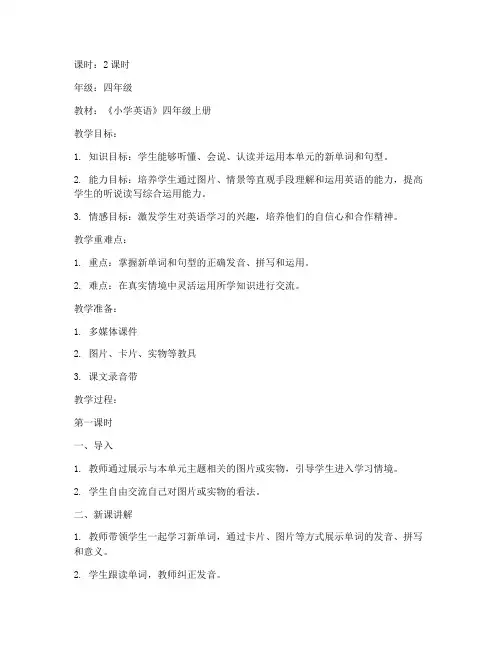
课时:2课时年级:四年级教材:《小学英语》四年级上册教学目标:1. 知识目标:学生能够听懂、会说、认读并运用本单元的新单词和句型。
2. 能力目标:培养学生通过图片、情景等直观手段理解和运用英语的能力,提高学生的听说读写综合运用能力。
3. 情感目标:激发学生对英语学习的兴趣,培养他们的自信心和合作精神。
教学重难点:1. 重点:掌握新单词和句型的正确发音、拼写和运用。
2. 难点:在真实情境中灵活运用所学知识进行交流。
教学准备:1. 多媒体课件2. 图片、卡片、实物等教具3. 课文录音带教学过程:第一课时一、导入1. 教师通过展示与本单元主题相关的图片或实物,引导学生进入学习情境。
2. 学生自由交流自己对图片或实物的看法。
二、新课讲解1. 教师带领学生一起学习新单词,通过卡片、图片等方式展示单词的发音、拼写和意义。
2. 学生跟读单词,教师纠正发音。
3. 教师讲解本单元的句型,通过例句和情景演示,让学生理解句型的用法。
4. 学生跟读句型,教师纠正发音。
三、练习1. 学生完成教材中的练习题,巩固所学知识。
2. 教师分组进行情景对话练习,让学生在实际情境中运用所学知识。
四、总结1. 教师对本节课所学内容进行总结,强调重点和难点。
2. 学生回顾所学知识,分享自己的学习心得。
第二课时一、复习1. 教师组织学生进行单词和句型的听写练习,巩固所学知识。
2. 学生相互检查,教师点评。
二、拓展1. 教师带领学生进行与本单元主题相关的课外阅读,拓宽学生的视野。
2. 学生分享自己的阅读感受。
三、情景对话1. 教师创设与本单元主题相关的情景,让学生进行角色扮演。
2. 学生在情景中运用所学知识进行交流,教师点评并给予指导。
四、总结1. 教师对本节课所学内容进行总结,强调重点和难点。
2. 学生回顾所学知识,分享自己的学习心得。
教学评价:1. 课堂表现:观察学生在课堂上的参与程度、发言积极性等。
2. 作业完成情况:检查学生作业的正确性和完成度。
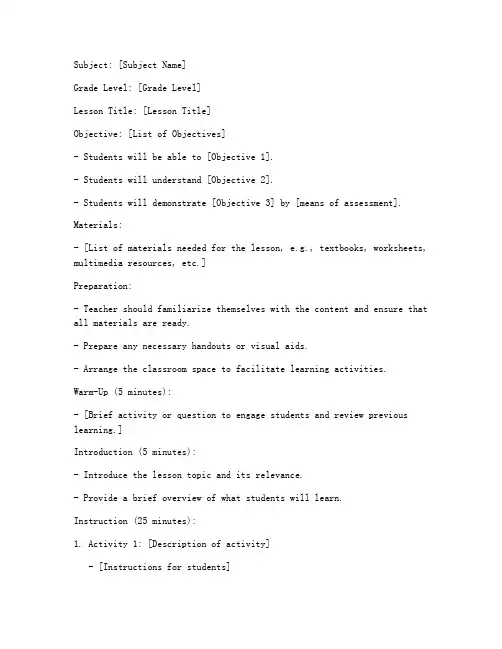
Subject: [Subject Name]Grade Level: [Grade Level]Lesson Title: [Lesson Title]Objective: [List of Objectives]- Students will be able to [Objective 1].- Students will understand [Objective 2].- Students will demonstrate [Objective 3] by [means of assessment].Materials:- [List of materials needed for the lesson, e.g., textbooks, worksheets, multimedia resources, etc.]Preparation:- Teacher should familiarize themselves with the content and ensure that all materials are ready.- Prepare any necessary handouts or visual aids.- Arrange the classroom space to facilitate learning activities.Warm-Up (5 minutes):- [Brief activity or question to engage students and review previous learning.]Introduction (5 minutes):- Introduce the lesson topic and its relevance.- Provide a brief overview of what students will learn.Instruction (25 minutes):1. Activity 1: [Description of activity]- [Instructions for students]- [Materials needed]- [Duration]- [Purpose]2. Activity 2: [Description of activity]- [Instructions for students]- [Materials needed]- [Duration]- [Purpose]3. Group Discussion: [Topic for discussion]- [Guiding questions or prompts]- [Duration]- [Purpose]Application (15 minutes):- Have students apply what they've learned to a new situation or problem.- Provide a real-world context or a practical task.Independent Work (10 minutes):- Students work independently on an activity or assignment that reinforces the lesson's objectives.Assessment (10 minutes):- Students will be assessed on their understanding and application of the lesson's content.- Assessment methods may include:- Oral responses- Written work- Group presentations- Exit ticketsClosing (5 minutes):- Summarize the key points of the lesson.- Encourage students to reflect on what they have learned.- Assign homework or discuss the next lesson.Extension Activities:- [List any additional activities that can be done to extend learning beyond the classroom.]Homework:- [Assign relevant homework that reinforces the lesson's objectives.]Vignette:Subject: MathematicsGrade Level: 5th GradeLesson Title: Understanding Multiplication of FractionsObjective:- Students will be able to multiply fractions and simplify the resulting product.- Students will understand the concept of multiplying fractions and how it relates to whole numbers.- Students will demonstrate their ability to multiply fractions by solving real-world problems.Materials:- Textbooks- Whiteboard and markers- Fraction tiles or manipulatives- Worksheets with multiplication of fractions problems- Calculator (optional)Preparation:- Teacher should prepare the whiteboard with key examples and explanations.- Ensure that fraction tiles or manipulatives are available for each student.Warm-Up (5 minutes):- Ask students to recall how to multiply whole numbers.- Ask for examples of multiplication problems they can solve quickly.Introduction (5 minutes):- Introduce the lesson by explaining that today we will learn how to multiply fractions.- Explain that multiplying fractions is similar to multiplying whole numbers but with an added step of simplifying the result.Instruction (25 minutes):1. Activity 1: Exploring Fraction Multiplication- Distribute fraction tiles to each student.- Instruct students to represent a fraction on their tiles and then multiply it by another fraction.- Discuss how the multiplication process works and how it relates to whole numbers.2. Activity 2: Simplifying Products- Have students multiply。
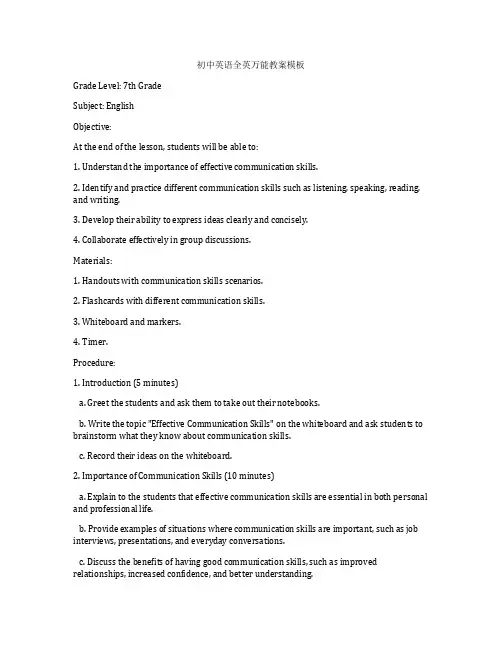
初中英语全英万能教案模板Grade Level: 7th GradeSubject: EnglishObjective:At the end of the lesson, students will be able to:1. Understand the importance of effective communication skills.2. Identify and practice different communication skills such as listening, speaking, reading, and writing.3. Develop their ability to express ideas clearly and concisely.4. Collaborate effectively in group discussions.Materials:1. Handouts with communication skills scenarios.2. Flashcards with different communication skills.3. Whiteboard and markers.4. Timer.Procedure:1. Introduction (5 minutes)a. Greet the students and ask them to take out their notebooks.b. Write the topic "Effective Communication Skills" on the whiteboard and ask students to brainstorm what they know about communication skills.c. Record their ideas on the whiteboard.2. Importance of Communication Skills (10 minutes)a. Explain to the students that effective communication skills are essential in both personal and professional life.b. Provide examples of situations where communication skills are important, such as job interviews, presentations, and everyday conversations.c. Discuss the benefits of having good communication skills, such as improved relationships, increased confidence, and better understanding.3. Identifying Communication Skills (10 minutes)a. Hand out the flashcards with different communication skills (e.g., listening, speaking, reading, writing) to the students.b. Ask students to work in pairs and practice identifying the different communication skills mentioned in the scenarios.c. Encourage students to ask questions and clarify their understanding.4. Group Discussions (15 minutes)a. Divide the class into small groups of 3-4 students.b. Hand out the handouts with communication skills scenarios to each group.c. Instruct each group to practice the scenarios and discuss the communication skills required in each situation.d. Encourage students to take turns speaking and listening.5. Role-Plays (10 minutes)a. Ask each group to choose one scenario from their handouts and perform a role-play in front of the class.b. Provide each group with a timer and instruct them to complete the role-play within 2 minutes.c. Encourage students to focus on using clear and concise language, maintaining eye contact, and using appropriate body language.6. Feedback and Reflection (5 minutes)a. Provide feedback to each group, highlighting their strengths and areas for improvement.b. Ask students to reflect on their own communication skills and identify areas they want to work on.c. Encourage students to practice their communication skills both in and outside of the classroom.7. Closure (5 minutes)a. Summarize the importance of effective communication skills.b. Remind students to continue practicing their communication skills in all aspects of their lives.c. Thank the students for their participation and dismiss the class.Assessment:1.观察学生在角色扮演中的表现,评估他们的听说能力以及沟通技巧的运用。
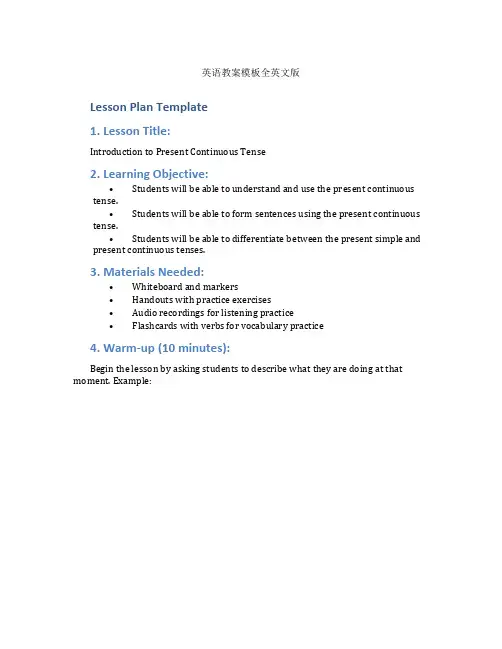
英语教案模板全英文版
Lesson Plan Template
1. Lesson Title:
Introduction to Present Continuous Tense
2. Learning Objective:
• Students will be able to understand and use the present continuous
tense.
• Students will be able to form sentences using the present continuous
tense.
• Students will be able to differentiate between the present simple and
present continuous tenses.
3. Materials Needed:
• Whiteboard and markers
• Handouts with practice exercises
• Audio recordings for listening practice
• Flashcards with verbs for vocabulary practice
4. Warm-up (10 minutes):
Begin the lesson by asking students to describe what they are doing at that
moment. Example:
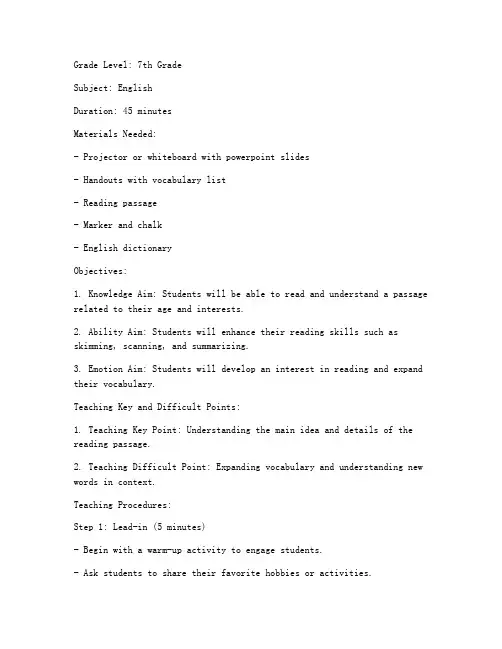
Grade Level: 7th GradeSubject: EnglishDuration: 45 minutesMaterials Needed:- Projector or whiteboard with powerpoint slides- Handouts with vocabulary list- Reading passage- Marker and chalk- English dictionaryObjectives:1. Knowledge Aim: Students will be able to read and understand a passage related to their age and interests.2. Ability Aim: Students will enhance their reading skills such as skimming, scanning, and summarizing.3. Emotion Aim: Students will develop an interest in reading and expand their vocabulary.Teaching Key and Difficult Points:1. Teaching Key Point: Understanding the main idea and details of the reading passage.2. Teaching Difficult Point: Expanding vocabulary and understanding new words in context.Teaching Procedures:Step 1: Lead-in (5 minutes)- Begin with a warm-up activity to engage students.- Ask students to share their favorite hobbies or activities.- Introduce the topic of the reading passage and explain its relevance to their lives.Step 2: Pre-reading (5 minutes)- Show a few pictures related to the topic and ask students to predict what the passage might be about.- Discuss the title of the passage and its possible implications.Step 3: While-reading (20 minutes)- Read the passage aloud, or have a student read it.- Encourage students to follow along and take notes.- After reading, ask questions to check for understanding:- What is the main idea of the passage?- What are the key details?- How does the author support their points?Step 4: Post-reading (10 minutes)- Have students work in pairs or small groups to summarize the passage.- Discuss the main themes and ideas of the passage.- Introduce new vocabulary words from the passage and provide examples of their usage.- Have students practice using the new vocabulary in sentences.Step 5: Consolidation (10 minutes)- Play a vocabulary game to reinforce the new words. (e.g., vocabulary bingo, word search)- Assign a homework task to further practice the new vocabulary and reading skills.- Review the lesson and provide feedback to students.Assessment:- Evaluate students' understanding of the reading passage through class discussions and questions.- Assess students' vocabulary knowledge through the vocabulary game and homework assignment.Follow-up Activities:- Encourage students to read additional materials related to the topic of the passage.- Plan a future lesson where students can present their findings or opinions on the topic.Evaluation:- Monitor student participation and engagement during the lesson.- Assess students' reading comprehension and vocabulary retention through quizzes and assignments.Conclusion:- Summarize the main points of the lesson and encourage students to continue developing their reading and vocabulary skills.Note: This is a template for a full English lesson plan. Adjustments can be made based on the specific needs and abilities of the students.。
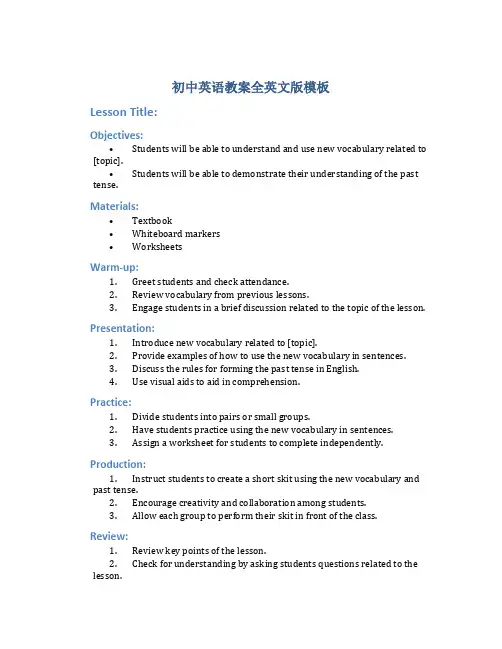
初中英语教案全英文版模板Lesson Title:Objectives:•Students will be able to understand and use new vocabulary related to [topic].•Students will be able to demonstrate their understanding of the past tense.Materials:•Textbook•Whiteboard markers•WorksheetsWarm-up:1.Greet students and check attendance.2.Review vocabulary from previous lessons.3.Engage students in a brief discussion related to the topic of the lesson. Presentation:1.Introduce new vocabulary related to [topic].2.Provide examples of how to use the new vocabulary in sentences.3.Discuss the rules for forming the past tense in English.e visual aids to aid in comprehension.Practice:1.Divide students into pairs or small groups.2.Have students practice using the new vocabulary in sentences.3.Assign a worksheet for students to complete independently. Production:1.Instruct students to create a short skit using the new vocabulary and past tense.2.Encourage creativity and collaboration among students.3.Allow each group to perform their skit in front of the class. Review:1.Review key points of the lesson.2.Check for understanding by asking students questions related to the lesson.3.Assign homework to reinforce the new vocabulary and past tense.Assessment:•Observe students’ participation during activities.•Evaluate students’ u nderstanding based on their performance in the skit and completion of the worksheet.Extension:•Provide additional resources for students who want to further practice the new vocabulary and past tense.•Encourage students to use the new vocabulary in their everyday conversations.Closure:•Review the main points of the lesson.•Thank students for their participation and effort.This lesson plan template serves as a guide for teachers to structure their lessons effectively and engage students in learning English. It provides a framework for teachers to introduce new vocabulary, practice language skills, and assess students’ understanding. By following this template, teachers can create engaging and comprehensive English lessons for middle school students.。
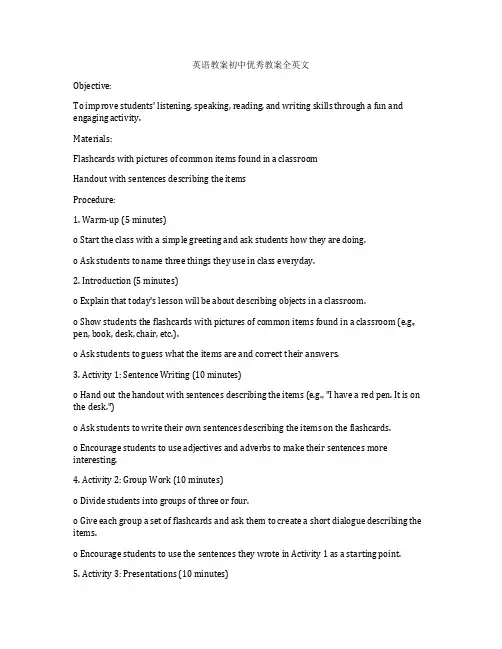
英语教案初中优秀教案全英文Objective:To improve students' listening, speaking, reading, and writing skills through a fun and engaging activity.Materials:Flashcards with pictures of common items found in a classroomHandout with sentences describing the itemsProcedure:1. Warm-up (5 minutes)o Start the class with a simple greeting and ask students how they are doing.o Ask students to name three things they use in class everyday.2. Introduction (5 minutes)o Explain that today's lesson will be about describing objects in a classroom.o Show students the flashcards with pictures of common items found in a classroom (e.g., pen, book, desk, chair, etc.).o Ask students to guess what the items are and correct their answers.3. Activity 1: Sentence Writing (10 minutes)o Hand out the handout with sentences describing the items (e.g., "I have a red pen. It is on the desk.")o Ask students to write their own sentences describing the items on the flashcards.o Encourage students to use adjectives and adverbs to make their sentences more interesting.4. Activity 2: Group Work (10 minutes)o Divide students into groups of three or four.o Give each group a set of flashcards and ask them to create a short dialogue describing the items.o Encourage students to use the sentences they wrote in Activity 1 as a starting point.5. Activity 3: Presentations (10 minutes)o Ask each group to present their dialogue to the class.o Encourage students to speak clearly and use proper pronunciation.6. Cool-down (5 minutes)o Ask students to reflect on what they learned today and share their thoughts with a partner. o Encourage students to practice describing objects in their daily lives to improve their English skills.Assessment:The teacher will assess students' participation in group work and their presentations. The teacher will also collect and review students' written sentences to assess their understanding of the lesson.Note: This lesson plan can be adjusted to suit different levels of English proficiency and can be used with students of different ages.。
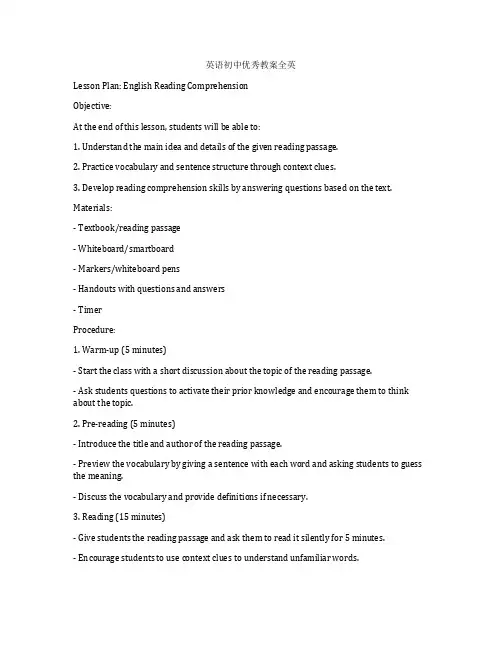
英语初中优秀教案全英Lesson Plan: English Reading ComprehensionObjective:At the end of this lesson, students will be able to:1. Understand the main idea and details of the given reading passage.2. Practice vocabulary and sentence structure through context clues.3. Develop reading comprehension skills by answering questions based on the text. Materials:- Textbook/reading passage- Whiteboard/smartboard- Markers/whiteboard pens- Handouts with questions and answers- TimerProcedure:1. Warm-up (5 minutes)- Start the class with a short discussion about the topic of the reading passage.- Ask students questions to activate their prior knowledge and encourage them to think about the topic.2. Pre-reading (5 minutes)- Introduce the title and author of the reading passage.- Preview the vocabulary by giving a sentence with each word and asking students to guess the meaning.- Discuss the vocabulary and provide definitions if necessary.3. Reading (15 minutes)- Give students the reading passage and ask them to read it silently for 5 minutes.- Encourage students to use context clues to understand unfamiliar words.- After the silent reading, ask students to summarize the main idea of the passage in their own words.4. Comprehension Questions (10 minutes)- Give students a handout with comprehension questions based on the reading passage.- Allow students to work in pairs or groups to answer the questions.- Encourage students to use the text to find the answers and support their answers with evidence from the text.5. vocabulary Practice (5 minutes)- Write down the vocabulary words on the whiteboard/smartboard.- Ask students to create sentences using the vocabulary words.- Encourage students to use the words in context and provide feedback on their sentences.6. Closure (5 minutes)- Review the main idea and key details of the reading passage.- Ask students if they have any questions or comments about the text.- Summarize the important points and encourage students to think about the topic further.7. Assessment (5 minutes)- Give students a short quiz or handout with fill-in-the-blank questions based on the reading passage.- Allow students to work independently to complete the assessment.- Collect the assessments and provide feedback to students.Extensions:- For advanced students, provide more challenging reading passages and comprehension questions.- For struggling students, provide additional support and guidance during the reading and comprehension activities.- Encourage students to read additional texts on the same topic to deepen their understanding.Note: This is just one example of an excellent English junior high school teaching plan. Depending on the specific needs and goals of your students, you can modify and adapt the plan to suit your teaching style and classroom environment.。
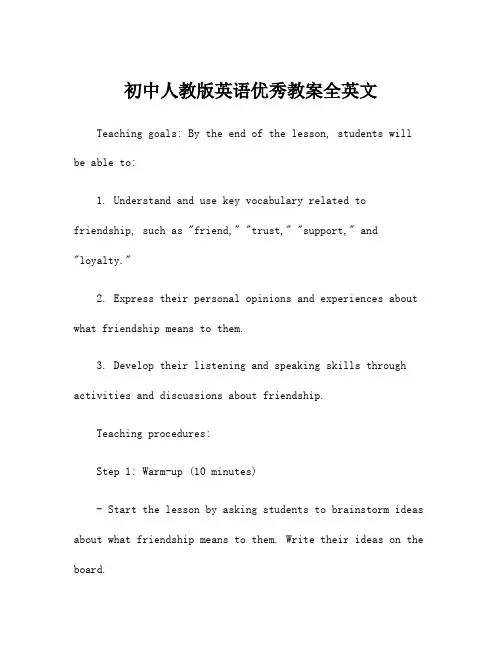
初中人教版英语优秀教案全英文 Teaching goals: By the end of the lesson, students will be able to:
1. Understand and use key vocabulary related to friendship, such as "friend," "trust," "support," and "loyalty."
2. Express their personal opinions and experiences about what friendship means to them.
3. Develop their listening and speaking skills through activities and discussions about friendship.
Teaching procedures: Step 1: Warm-up (10 minutes) - Start the lesson by asking students to brainstorm ideas about what friendship means to them. Write their ideas on the board. - Use the Think-Pair-Share strategy to have students discuss their ideas with a partner before sharing with the class.
Step 2: Vocabulary introduction (15 minutes) - Introduce key vocabulary related to friendship, such as "friend," "trust," "support," and "loyalty." Provide definitions, synonyms, and examples for each word.
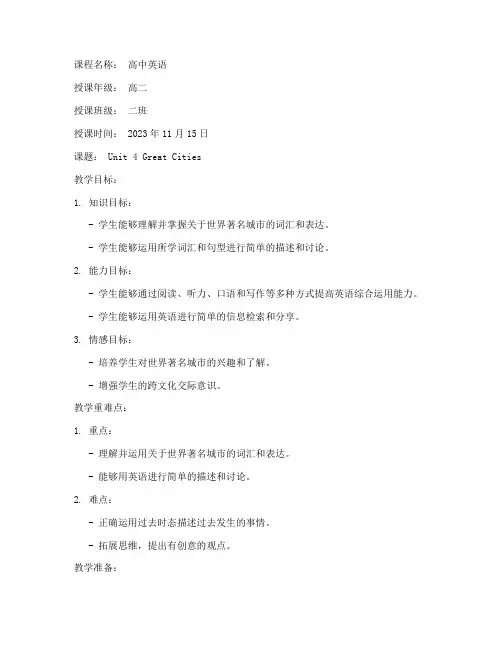
课程名称:高中英语授课年级:高二授课班级:二班授课时间: 2023年11月15日课题: Unit 4 Great Cities教学目标:1. 知识目标:- 学生能够理解并掌握关于世界著名城市的词汇和表达。
- 学生能够运用所学词汇和句型进行简单的描述和讨论。
2. 能力目标:- 学生能够通过阅读、听力、口语和写作等多种方式提高英语综合运用能力。
- 学生能够运用英语进行简单的信息检索和分享。
3. 情感目标:- 培养学生对世界著名城市的兴趣和了解。
- 增强学生的跨文化交际意识。
教学重难点:1. 重点:- 理解并运用关于世界著名城市的词汇和表达。
- 能够用英语进行简单的描述和讨论。
2. 难点:- 正确运用过去时态描述过去发生的事情。
- 拓展思维,提出有创意的观点。
教学准备:1. 教学课件2. 世界著名城市的相关图片或视频3. 词汇卡片4. 练习题教学过程:一、导入(5分钟)1. 利用多媒体展示世界著名城市的图片或视频,激发学生的学习兴趣。
2. 引导学生讨论:“What do you think of these cities? Why do you like them?”二、新课讲授(20分钟)1. 词汇学习:- 展示词汇卡片,引导学生认读和拼写。
- 通过游戏或活动帮助学生记忆词汇。
2. 句型学习:- 教授过去时态的构成和用法。
- 通过例句讲解句型的运用。
3. 阅读理解:- 分组阅读关于世界著名城市的文章。
- 引导学生总结文章大意,并回答相关问题。
三、课堂活动(15分钟)1. 小组讨论:- 学生分组讨论自己感兴趣的世界著名城市,并分享自己的看法。
2. 角色扮演:- 学生分组扮演不同的角色,用英语进行对话。
四、巩固练习(10分钟)1. 完成课后练习题,巩固所学知识。
2. 教师检查学生的练习情况,并给予个别指导。
五、总结与作业(5分钟)1. 总结本节课所学内容,强调重点和难点。
2. 布置作业:- 阅读相关书籍或文章,了解更多的世界著名城市。
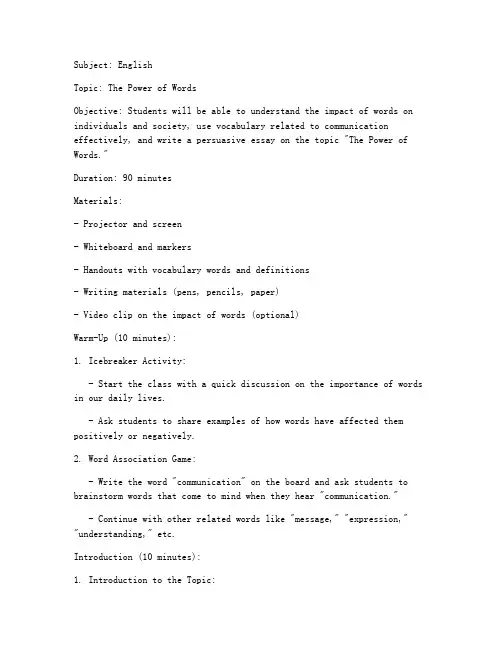
Subject: EnglishTopic: The Power of WordsObjective: Students will be able to understand the impact of words on individuals and society, use vocabulary related to communication effectively, and write a persuasive essay on the topic "The Power of Words."Duration: 90 minutesMaterials:- Projector and screen- Whiteboard and markers- Handouts with vocabulary words and definitions- Writing materials (pens, pencils, paper)- Video clip on the impact of words (optional)Warm-Up (10 minutes):1. Icebreaker Activity:- Start the class with a quick discussion on the importance of words in our daily lives.- Ask students to share examples of how words have affected them positively or negatively.2. Word Association Game:- Write the word "communication" on the board and ask students to brainstorm words that come to mind when they hear "communication."- Continue with other related words like "message," "expression," "understanding," etc.Introduction (10 minutes):1. Introduction to the Topic:- Explain that words have the power to inspire, heal, hurt, and even change the world.- Introduce the topic "The Power of Words" and its relevance in society.2. Video Clip (optional):- Show a short video clip that illustrates the impact of words on individuals and society.- Discuss the video with students, asking them to identify moments when words had a significant impact.Vocabulary Development (15 minutes):1. Vocabulary Introduction:- Hand out a list of vocabulary words related to communication and their definitions.- Go through each word and provide examples of how they are used in context.2. Group Activity:- Divide the class into small groups.- Each group is given a scenario where words are used in different ways (e.g., comforting a friend, arguing with a sibling, giving a speech).- Students discuss how the choice of words in each scenario could affect the outcome.Reading Activity (15 minutes):1. Reading Selection:- Provide a short reading passage that explores the power of words.- Ask students to read the passage silently and then discuss key points.2. Discussion Questions:- What are some examples of powerful words mentioned in the passage?- How can words bring about change in society?Writing Activity (30 minutes):1. Writing Prompt:- Hand out a writing prompt: "The Power of Words: Write a persuasive essay explaining how words can have a positive or negative impact on individuals and society. Support your argument with examples from your own experiences or from the readings."2. Guided Writing:- Guide students through the writing process, starting with brainstorming ideas and organizing their thoughts.- Encourage students to use the vocabulary words they learned intheir essay.3. Peer Review:- Pair students up to review each other's essays, offering constructive feedback.Conclusion (10 minutes):1. Reflection:- Have students reflect on what they have learned about the power of words.- Ask for volunteers to share their essays or key points from their discussions.2. Homework Assignment:- Assign a follow-up activity where students are to keep a journal of the words they use in their daily interactions and how those words might affect others.Assessment:- Evaluate students' participation in class discussions and activities.- Assess the quality of their essays based on content, organization, and use of vocabulary.- Monitor their ability to use the vocabulary words effectively in both speaking and writing.。
Teaching Objectives:- Knowledge Objective: Students will be able to understand and use the target vocabulary and grammar structures correctly in different contexts.- Skill Objective: Students will enhance their listening, speaking, reading, and writing skills through various activities.- Emotional Objective: Students will develop an interest in English learning and improve their confidence in using the language.Teaching Materials:- Textbook- Workbook- Flashcards- Whiteboard and markers- Multimedia resources (e.g., videos, songs)Teaching Procedures:I. Warm-up (5 minutes)1. Greeting: Begin with a greeting and ask students to introduce themselves in English.2. Review: Quick review of previously learned vocabulary or grammar.3. Icebreaker: A short activity to engage students, such as a riddle ora quick quiz.II. Presentation (10 minutes)1. Vocabulary: Introduce new vocabulary through pictures, flashcards, or realia.2. Grammar: Explain the target grammar structure with simple examples and explanations.3. Demonstration: Model the correct usage of vocabulary and grammar through a short dialogue or story.III. Practice (15 minutes)1. Pair Work: Students work in pairs to practice using the new vocabulary and grammar.2. Group Activity: Small group activities that require students to apply the language in a real-life context.3. Role-Play: Students act out a scenario using the new vocabulary and grammar.IV. Production (10 minutes)1. Creative Writing: Students write a short paragraph or a dialogue using the new vocabulary and grammar.2. Oral Presentation: Students present their writing to the class, and peers can give feedback.3. Game: A language game that reinforces the target vocabulary and grammar.V. Consolidation (10 minutes)1. Summary: Review the main points of the lesson.2. Homework Assignment: Assign a homework task related to the lesson, such as writing a journal entry or preparing for a quiz.3. Closing Activity: A fun activity to review the lesson, such as a song or a game.VI. Assessment (Throughout the lesson)- Formative Assessment: Observe students' participation, engagement, and ability to use the language during activities.- Summative Assessment: Evaluate students' understanding of the new vocabulary and grammar through quizzes, tests, or presentations.Teaching Tips:- Use visuals and realia to make the lesson more engaging.- Encourage students to speak in complete sentences and provide positive feedback.- Be patient and supportive, especially with students who may be nervous or struggling.- Incorporate different learning styles into the lesson to cater to all students.Example of a Lesson Plan:Lesson Title: "My Hobbies"Teaching Objectives:- Students will be able to describe their hobbies using the present simple tense.- Students will practice listening and speaking skills by discussing their hobbies with classmates.Teaching Procedures:I. Warm-up:- Greeting and introduction.- Quick review of the present simple tense with a flashcard activity.II. Presentation:- Introduce new vocabulary related to hobbies (e.g., painting, reading, traveling).- Demonstrate the present simple tense with examples and a short dialogue.III. Practice:- Pair work activity: Students discuss their hobbies with a partner.- Group activity: Students create a poster showcasing their hobbies.IV. Production:- Creative writing: Students write a short paragraph about their favorite hobby.- Oral presentation: Students present their paragraph to the class.V. Consolidation:- Summary of the lesson.- Homework assignment: Write a journal entry about。
优秀全英文教案模板 Instructional design Name: 李鑫颖 Grade: Grade 8 Subject: Have You Ever Been to an Amusement Park?
Lesson type: Listening and Speaking Teaching time: 40 minutes Overall Design and Guiding Principles This is a listening and speaking lesson which aims to develop students’ ability in talking about past experience. Meanwhile, students’ linguistic and cultural knowledge is expected to be enriched through listening and speaking activities. In this lesson I mainly employed Task-based Teaching Method, Natural Approach as well as the Communicative Language Teaching Method to create certain scene and ask students to complete relevant tasks, assist them to learn in a relaxed atmosphere and build a confidence towards listening, thus forming the habit of active learning and improving their comprehensive language competence. First of all, drawing on the Natural Approach, the lesson will start a real-life conversation to lead in the topic and showing a video clip of amusement park to arouse students’ curiosity. Then I will show some pictures featuring the new words (amusement park, space museum, aquarium, zoo) to impress students the key words so as to make preparation for the following listening session. In the third section, I mainly use Task-based Teaching Method by setting three tasks of extensive listening, intensive listening, as well as focused listening to assist students to fully understand the listening materials and grasp the method of talking about past experience subconsciously. With the former three sections, students will receive a large amount of input of the present perfect tense structure ”have been to ……”, then in the next section I designed a memory game to train students’ ability of transforming input into output through speaking. Finally, I will ask students to role play and report. This section is an evaluation of students’ command of present perfect tense structure ”have been to ……”and their ability of talking about past experience. Therefore, this section is employed as a reinforcement of students’ comprehensive language competence. Teaching Context
Analysis of teaching material: This is a listening and speaking lesson. The lesson focuses on talking about past experience, aiming at letting students grasp the present perfect tense structure ”have been to ……”. The topic of this unit is closely related to students’ real life, and in accord with students cognitive level, thus can make students learn meaningfully and build students a confidence of English learning. This lesson mainly consists of warming up, listening and speaking parts. The first warming-up part mainly is intended to teach new words with the help of video clip and vivid pictures so as to build in students’ mind a structure of new knowledge. Then the second listening section aims at providing students with initial input of the language structure ”have been to ……”by way of listening and the linguistic expressions to talk about past experience subconsciously. Finally, the third speaking session mainly consists of memory game, role play and reporting tasks targets at improving students’ ability of language output, and thus realizing the goal of communicative teaching. Therefore, the three sections of this unit, abiding by the “output after input” sequential principle in teaching, progress step by step, and proceed from experience to exploration and finally to language application. All these can effectively realise the objectives of improving students’ comprehensive language competence.
Analysis of students: The objects of this lesson are students in Grade 8. Students in this phase has already learned some tenses such as simple past tense, present progressive tense, thus they must have mastered some skills of tense-learning and fully prepared to learn the lesson cognitively. However, junior students lack the ability of systematic autonomous language learning and some students have on confidence of English learning. Therefore, it requires teachers to set up the tasks from easy to the advanced to guide them. What’s more, junior students tend to focus on image thinking because of the absence of the mature, abstract, and logical thinking, thus teachers should design various interesting, fun and relaxing activities to sustain students’ interests and attention. Teaching Aims
Aims of knowledge: (1) master and use some important words, such as: amusement park, space museum, aquarium, zoo and so on. (2) be able to use the present perfect tense structure ”have been to ……”.